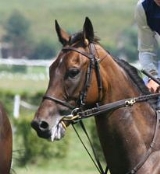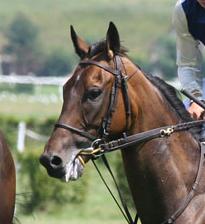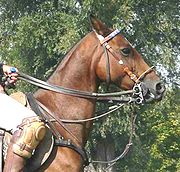
Draw reins and running reins
Encyclopedia

Mechanical advantage
Mechanical advantage is a measure of the force amplification achieved by using a tool, mechanical device or machine system. Ideally, the device preserves the input power and simply trades off forces against movement to obtain a desired amplification in the output force...
of a 'single movable pulley' to cause the horse to bring its head down and inward. While a regular rein
Rein
Reins are items of horse tack, used to direct a horse or other animal used for riding or driving. Reins can be made of leather, nylon, metal, or other materials, and attach to a bridle via either its bit or its noseband.-Use for riding:...
is the strap that attaches to the bit
Bit (horse)
A bit is a type of horse tack used in equestrian activities, usually made of metal or a synthetic material, and is placed in the mouth of a horse or other equid and assists a rider in communicating with the animal. It rests on the bars of the mouth in an interdental region where there are no teeth...
and is held by the rider, these types of reins slide through the bit ring
Bit ring
The bit ring is the ring on the side of a horse's bit, particularly on a snaffle bit. It is used as a point of attachment for the cheekpieces of the bridle and for the reins. It also has an effect on the action of the bit...
, adding leverage to the rider's hands and arms, allowing the rider to force the horse's head into a desired position.
Usage of the term in English riding
English riding
English riding is a term used to describe a form of horse riding that is seen throughout the world. There are many variations in English riding, but all feature a flat English saddle without the deep seat, high cantle or saddle horn seen on a Western saddle nor the knee pads seen on an Australian...
and Western riding
Western riding
Western riding is a style of horseback riding which evolved from the ranching and warfare traditions brought to the Americas by the Spanish Conquistadors, and both equipment and riding style evolved to meet the working needs of the cowboy in the American West...
disciplines refers to slightly different designs that nonetheless work on essentially the same leverage principles.
English Riding
The terms "draw reins" and "running reins" are often used interchangeably in the English disciplines. The terms most often refer to reins which go from the rider's hand, through one bit ring (outside to inside), and attach to the girth. Usually this style is called a "running rein," though the term "draw rein" is also sometimes used. Some styles attach directly to a regular snaffle rein, which limits the degree of force applied, while others slide freely and with little limit to the leverage that can be applied. Another style, also called a "draw rein," runs from the rider's hands, through the bit ring (outside to inside), over the poll, through the other bit ring, and back to the rider's hands, without attaching to the girthGirth (tack)
A girth, sometimes called a cinch , is a piece of equipment used to keep the saddle in place on a horse or other animal. It passes under the barrel of the equine, usually attached to the saddle on both sides by two or three leather straps called billets...
.
In Hunt seat
Hunt seat
Hunt seat is terminology used in the United States and Canada to refer to a style of forward seat riding commonly found at American horse shows. Along with Dressage, it is one of the two classic forms of English riding. The Hunt seat is based on the tradition of fox hunting...
style English riding
English riding
English riding is a term used to describe a form of horse riding that is seen throughout the world. There are many variations in English riding, but all feature a flat English saddle without the deep seat, high cantle or saddle horn seen on a Western saddle nor the knee pads seen on an Australian...
, these devices originally developed as a two-rein bitting system. One set of reins is an ordinary direct snaffle rein, and the other is the running or draw rein. The rider holds these reins in a manner similar to a double bridle
Double bridle
A double bridle, also called a full bridle or Weymouth bridle, is a bridle that has two bits and four reins . One bit is the bradoon , is a modified snaffle bit that is smaller in diameter and has smaller bit rings than a traditional snaffle, and it is adjusted so that it sits above and behind the...
, usually with the snaffle rein below the fourth finger and the running or draw rein between the third and fourth fingers, although there are variations on this. When riding in this fashion, the rider should ride predominantly on the snaffle rein. However, riders and trainers may often be observed using only the running or draw rein, in many cases with the snaffle rein completely absent from the bridle. Riding with draw reins alone is a controversial practice among English riders.
Western Riding
Draw reins in the western ridingWestern riding
Western riding is a style of horseback riding which evolved from the ranching and warfare traditions brought to the Americas by the Spanish Conquistadors, and both equipment and riding style evolved to meet the working needs of the cowboy in the American West...
disciplines are always attached to the rings of the cinch (a western-style girth
Girth (tack)
A girth, sometimes called a cinch , is a piece of equipment used to keep the saddle in place on a horse or other animal. It passes under the barrel of the equine, usually attached to the saddle on both sides by two or three leather straps called billets...
), usually on each side of a western saddle
Western saddle
Western saddles are used for western riding and are the saddles used on working horses on cattle ranches throughout the United States, particularly in the west. They are the "cowboy" saddles familiar to movie viewers, rodeo fans, and those who have gone on trail rides at guest ranches...
, run through the bit rings (either inside to outside or vice-versa, there is no firm rule, though the rein moves more smoothly if the inside goes to the girth and the outside to the hand), and then to the hands of the rider. They are rarely used in a two-rein system, usually are used alone or used with the regular bridle reins allowed to lay slack and not held by the rider. While use of the standard draw reins presents only mild controversy in western circles, a controversial use of this rein in western riding is its use on a curb bit
Curb bit
A curb bit is a type of bit used for riding horses that uses lever action. It includes the pelham bit and the Weymouth curb along with the traditional "curb bit" used mainly by Western riders....
, a practice that applies incorrect leverage, is dangerous, and creates an effect that some consider abusive.
Polo

Polo
Polo is a team sport played on horseback in which the objective is to score goals against an opposing team. Sometimes called, "The Sport of Kings", it was highly popularized by the British. Players score by driving a small white plastic or wooden ball into the opposing team's goal using a...
, connected through the "snaffle" bit ring
Bit ring
The bit ring is the ring on the side of a horse's bit, particularly on a snaffle bit. It is used as a point of attachment for the cheekpieces of the bridle and for the reins. It also has an effect on the action of the bit...
of a Pelham bit
Pelham bit
A pelham bit is a type of bit used when riding a horse. It has elements of both a curb bit and a snaffle bit. In this respect a pelham bit functions similar to a double bridle, and like a double bridle it normally has "double" reins: a set of curb reins and a set of snaffle reins. Because it has...
or a gag bit
Gag bit
The gag bit is a type of bit for a horse. With two sets of reins, the gag bit gives a rider the ability to use either a standard direct action or a gag action. In this, the gag bit is related to a Pelham bit and a double bridle...
in lieu of a direct rein, to the saddle billets. The draw reins have a direct rein action. A second pair of reins, on the "curb" bit ring, provides a lever
Lever
In physics, a lever is a rigid object that is used with an appropriate fulcrum or pivot point to either multiply the mechanical force that can be applied to another object or resistance force , or multiply the distance and speed at which the opposite end of the rigid object travels.This leverage...
action. When the rider pulls all four reins (both pairs) together, the draw reins become slack, transferring tension to the other pair of reins.
Uses
Running reins and draw reins are intended for use when the horse is performing an undesired behavior that cannot be corrected with less extreme equipment, and it is best practice to stop use as soon as the desired response is given.Running reins (or western-style draw reins) are used by many trainers to teach the horse to give to rein pressure, and most horses respond by bringing the head in and lowering it. They may also provide additional control of heavy-mouthed horses, though it can also become a "crutch" that a rider becomes dependent on using at all times.
English style draw reins that run over the poll have a gag bit
Gag bit
The gag bit is a type of bit for a horse. With two sets of reins, the gag bit gives a rider the ability to use either a standard direct action or a gag action. In this, the gag bit is related to a Pelham bit and a double bridle...
-like action. They encourage the horse to raise its head, although they may cause slight pressure on the poll
Poll (horse)
The poll is a name of the part of an animal's head, alternatively referencing a point immediately behind or right between the ears. This area of the anatomy is of particular significance for the horse....
, and are therefore good for certain horses that buck and plunge with the head lowered, attempt to run away by first lowering the head, and for horses that pull, lean on the bit, or have learned to lower the head and stop to unseat the rider
Western style draw reins work similarly to the English style running rein, in that they encourage the horse to bring its head down and in. However, they may apply more leverage and because western riders rarely use the regular rein, they offer less relief to the horse. Some trainers even run draw reins between the front legs and attach them to the cinch underneath the belly in order to get the horse to travel with the low and controversial "peanut roller" style headset popular in some western pleasure
Western Pleasure
Western Pleasure is a western style competition at horse shows that evaluates horses on manners and suitability of the horse for a relaxed but collected gait cadence and relatively slow speed of gait, along with calm and responsive disposition. The horse is to appear to be a "pleasure" to ride and...
classes. However, horses can learn to evade draw reins by overflexing and putting their head practically on their chest, then charging ahead or, conversely, balking and refusing to move forward at all.
Misuses and Dangers
There are many riders who use leverage devices, which also can include not only draw reins and running reins, but also the running martingaleMartingale (tack)
A martingale is any of several designs of tack that are used on horses to control head carriage. Martingales may be seen in a wide variety of equestrian disciplines, both riding and driving...
, to force the horse into position. However, this is incorrect usage.
Misuse usually involves the rider pulling the horse's head in to achieve a "headset" rather than getting the animal correctly on the bit
On the bit
The phrases "on the bit", "behind the bit" and "above the bit" are equestrian terms used to describe a horse's posture relative to the reins and the bridle bit. A position on the bit is submissive to the rider's rein aids, given through the bit. When a horse is behind the bit, the head is tucked...
. Like the equally controversial practice of rollkur
Rollkur
Rollkur or hyperflexion of the horse's neck is a practice in equestrianism defined as "flexion of the horse's neck achieved through aggressive force" and is banned by the world governing body, the International Federation for Equestrian Sports...
, the horse does not flex properly at the poll
Horse anatomy
Equine anatomy refers to the gross and microscopic anatomy of horses and other equids, including donkeys, and zebras. While all anatomical features of equids are described in the same terms as for other animals by the International Committee on Veterinary Gross Anatomical Nomenclature in the book...
, but rather flexes improperly at a lower neck vertebrae. This practice often results in a horse that is working in a "headset" or "outline" that, to the inexperienced observer appears acceptable, but the horse has no self-carriage or suppleness and does not properly engage its hindquarters.
These pieces of equipment can have very detrimental effects if they are adjusted tightly, used strongly, or if used for long periods of time. Horses may become hard-mouthed and heavy, and they will begin to travel on the forehand if the rider can not keep sufficient impulsion. Additionally, many horses that are continuously or incorrectly ridden in draw or running reins may never learn to engage the hind quarters and lift their withers for self-carriage, and this habit may permanently damage their training. In extreme cases, horses may develop neck and back pain from being forced to hold an artificial position for long periods of time.
It was this improper flexion that ruined the reputation of their inventor, William Cavendish, 1st Duke of Newcastle-upon-Tyne .
That being said, competent riders who correctly and tactfully use the draw and running reins can have success in correcting specific problems in horses that require retraining to get rid of bad habits. These are often the riders who use the equipment the least, because they can achieve correct results through good riding instead of gadgets.

